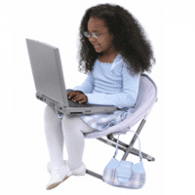Child Back Pain from Backpacks
Back problems are no longer limited to the elderly. Pediatricians are seeing more and more school children with back pain related to the misuse of backpacks. We don’t discourage the use of backpacks since compared with shoulder bags or purses backpacks are easier on the upper body muscles because these strong muscles support the weight more evenly than if the weight is carried on one side in heavy shoulder bags or purses. Studies have found that around 1/3 of children suffer from back pain, most of which may be related to improper use of their backpacks.
Even though orthopedists, pediatricians, and physical therapists recommend that a child should carry no more than 15% of their body weight in their backpacks, research shows that over half of the children studied carried loads heavier than 15% of their body weight. Younger children, especially girls, are at higher risk for backpack-related back pain since they tend to carry loads that are heavier proportional to their body weight. Symptoms associated with backpack misuse:
- Shoulder and low back pain, and muscle spasms
- Neck muscle pain and muscle spasms
- Numbness and tingling in the hands and fingers
Backpack Basics for Proper Use
Try these back-friendly tips:
Buy the best backpack.
Shop around and look for these safely and comfort features:
- Straps should be wide, well padded and preferably elastic. It’s amazing how slightly elastic and stretchable straps can minimize the weight. Some backpacks are equipped with a waist belt that keeps the pack anchored to the hips to avoid the extra weight swaying back and forth adding further strain to the backbones and muscles.
- Purchase a pack with multiple compartments, which allows you to place the heaviest weights closest to the back.
- Consider a pack on wheels.
Plan ahead for packing the pack.
Encourage your student to plan ahead for their homework and pack only the most necessary books to bring home. Leave as many heavy items in the school locker as possible.
Pack properly.
Place the heaviest books in the center of the pack and in the compartment closest to the spine (center the weight). Placing heavy items on the side of the pack or in the outer most compartments causes uneven weight bearing on the back muscles and encourages back arching and consequent back pain.
Wear the pack properly.
Adjust the straps to raise the top of the pack to shoulder height. Center the pack in the middle of the shoulders and tighten it close to the spine so it doesn’t dangle to one side. Be sure the straps are padded enough not to dig into the arm muscles which could impair circulation and cause numbness and tingling in the hands and fingers. Avoid leaning to one side while wearing the pack, which causes excessive strain on the backbone and muscles.
Lighten the load.
Be sure the loaded pack doesn’t weigh more than 15% of your child’s body weight, 10% is even safer. So if your child weighs 100 lbs limit the weight to 10 lbs. Weigh the loaded pack on the bathroom scale.
Pick up the pack properly.
Instead of leaning over to one side or stooping over, bend at the knees and lift with both legs when putting on the pack or when picking up something off the floor while wearing the pack.
If your child suffers from the back pain of backpacks immediately discontinue the use of the backpack and use a book-carrier on wheels instead.

